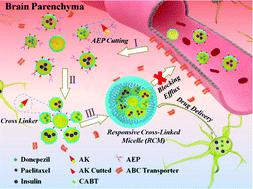当前位置:
X-MOL 学术
›
Biomater. Sci.
›
论文详情
Our official English website, www.x-mol.net, welcomes your
feedback! (Note: you will need to create a separate account there.)
Increased cross-linking micelle retention in the brain of Alzheimer's disease mice by elevated asparagine endopeptidase protease responsive aggregation
Biomaterials Science ( IF 5.8 ) Pub Date : 2020-10-07 , DOI: 10.1039/d0bm01439g Jian Ren 1, 2, 3, 4, 5 , Fuxin Jiang 1, 2, 3, 4, 5 , Ming Wang 1, 2, 3, 4, 5 , Haodong Hu 1, 2, 3, 4, 5 , Bo Zhang 1, 2, 3, 4, 5 , Li Chen 1, 2, 3, 4, 5 , Fengying Dai 1, 2, 3, 4, 5
Biomaterials Science ( IF 5.8 ) Pub Date : 2020-10-07 , DOI: 10.1039/d0bm01439g Jian Ren 1, 2, 3, 4, 5 , Fuxin Jiang 1, 2, 3, 4, 5 , Ming Wang 1, 2, 3, 4, 5 , Haodong Hu 1, 2, 3, 4, 5 , Bo Zhang 1, 2, 3, 4, 5 , Li Chen 1, 2, 3, 4, 5 , Fengying Dai 1, 2, 3, 4, 5
Affiliation

|
Current forms of medication for Alzheimer's disease (AD) provide a symptomatic benefit limited to those with early onset, but there is no single drug available for later stage patients. Given the recent failures of AD drugs in clinical trials, an intensive treatment strategy based on drug combination that is approved is attractive. At present, the greatest difficulty lies in the low accumulation of drugs in the brain. All hydrophilic drugs are limited by the physical and biochemical barriers within the blood–brain barrier and lipophilic drugs are often transported back into the blood by efflux pumps located in the blood–brain barrier. Here, we select elevated asparagine endopeptidase (AEP) as a target to trigger in situ cross-linking of small sized particles to form large sized drug clusters to block the efflux of the brain. Subsequently, responsive cross-linking micelles (RCMs) loaded with the acetylcholinesterase inhibitor, donepezil (DON), the microtubule therapeutic agent, Paclitaxel (PTX), and the glucose metabolism disorder regulator, insulin (INS) are investigated, with a focus on high levels of drug accumulation in the brain in AD. These smart multi-drug delivery RCMs provide a powerful system for AD treatment and can be adapted for other central nervous system (CNS) disorders.
中文翻译:

天冬酰胺天冬酰胺内肽酶蛋白酶反应性聚集增加了阿尔茨海默氏病小鼠大脑中交联胶束的保留
当前针对阿尔茨海默氏病(AD)的药物提供的症状缓解仅限于早期发作的患者,但尚无单一药物可用于晚期患者。鉴于AD药物最近在临床试验中失败,基于已获批准的药物组合的强化治疗策略很有吸引力。当前,最大的困难在于大脑中药物的低积累。所有亲水性药物都受到血脑屏障内的物理和生化屏障的限制,而亲脂性药物通常会通过位于血脑屏障内的外排泵运回到血液中。在这里,我们选择升高的天冬酰胺内肽酶(AEP)作为原位触发的靶标小颗粒的交联形成大的药物簇,从而阻断大脑的外排。随后,研究了负载有乙酰胆碱酯酶抑制剂多奈哌齐(DON),微管治疗剂紫杉醇(PTX)和葡萄糖代谢紊乱调节剂胰岛素(INS)的响应性交联胶束(RCM)。 AD中大脑中药物积累的水平。这些智能的多种药物输送RCM为AD治疗提供了强大的系统,并且可以适应其他中枢神经系统(CNS)疾病。
更新日期:2020-11-03
中文翻译:

天冬酰胺天冬酰胺内肽酶蛋白酶反应性聚集增加了阿尔茨海默氏病小鼠大脑中交联胶束的保留
当前针对阿尔茨海默氏病(AD)的药物提供的症状缓解仅限于早期发作的患者,但尚无单一药物可用于晚期患者。鉴于AD药物最近在临床试验中失败,基于已获批准的药物组合的强化治疗策略很有吸引力。当前,最大的困难在于大脑中药物的低积累。所有亲水性药物都受到血脑屏障内的物理和生化屏障的限制,而亲脂性药物通常会通过位于血脑屏障内的外排泵运回到血液中。在这里,我们选择升高的天冬酰胺内肽酶(AEP)作为原位触发的靶标小颗粒的交联形成大的药物簇,从而阻断大脑的外排。随后,研究了负载有乙酰胆碱酯酶抑制剂多奈哌齐(DON),微管治疗剂紫杉醇(PTX)和葡萄糖代谢紊乱调节剂胰岛素(INS)的响应性交联胶束(RCM)。 AD中大脑中药物积累的水平。这些智能的多种药物输送RCM为AD治疗提供了强大的系统,并且可以适应其他中枢神经系统(CNS)疾病。











































 京公网安备 11010802027423号
京公网安备 11010802027423号